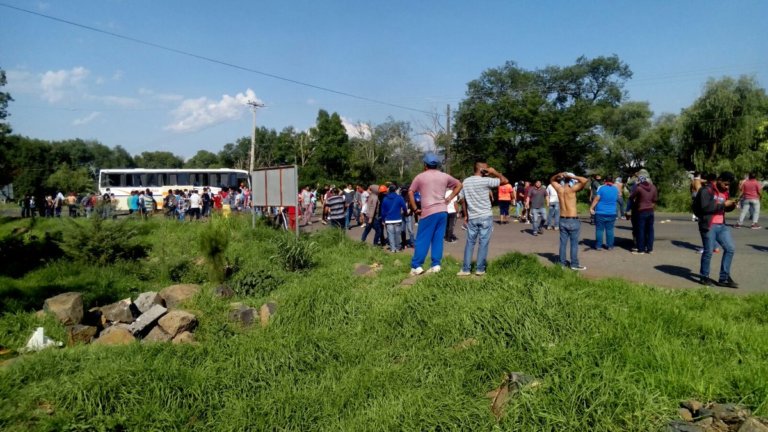December 23rd, 2006 – Luciente Zamora & Nina Armand write:
Tercer Informe:
Noche de Rabanos — Iglesia de Carmen Alto, Oax.
A group of teachers stand at a fold-up table cutting pieces of crepe paper and bunching them into colorful paper flowers. They string the flowers across branches and between trees. They are at the plazuela of the church, where the APPO’s alternative Noche de Rabanos has been relocated after 300 municipal police filled the famous Plaza de Santo Domingo in the zocalo. The police are here too, lining the entrances to the plazuela, with more camped a block away — riot gear ready.
The traditional brass instrument banda music in the air is accompanied by dancing on the stage. A few tourists and others walk past elaborate radish sculptures — battle scenes from the last six months were carved from huge radishes. There is a figure of the PFP, with club and shield out, and a helicopter hanging from a branch to simulate flying — with a body hanging out of it. Our favorite was the rabanos carved into a scene from the barricades: car-and-rock barricades manned by little figurines — both men and women — holding sticks with piles of rabanito rocks nearby.
Then the crowd in la plazuela stood still as a group of a couple dozen youth and residents arrived in a “posada.” Red and yellow light glowed from atop the tall wooden sticks holding candles in cellophane-wrapped frames. This time people weren’t singing Christmas songs or carrying pictures of nativity scenes or baby Jesus — they carried a big bright banner demanding freedom for all the political prisoners.
* * * * *
Lucia, Margarita, Eva, and Inez are teachers that were involved in the teachers strike and planton — “encampment” — since May. They said that it was a back and forth in the early days with many people in Oaxaca. Lucia said that at first many people were supportive, but that some started to grow tired of the planton. However after the June 14 repression things changed completely. The people were outraged at the way that the state had shot teargas into the encampment, injuring people and killing others, including at least one child. Margarita added that this struggle has been in the making for a long time and that it was a matter of time before it erupted into the open.
The women talked about the inequality that forms the base of this struggle, in particular the tremendous poverty and hunger throughout society. They then went on to describe another kind of inequality – the use of violent force. They pointed out that the state has the power to kill and repress with weapons and brute force and the people have had to confront that with resistance and defending their neighborhoods by building barricades made of cars, rocks, wood, bags filled with sand, etc.
The state has come down hard on those who rose up and participated and continue to participate in the struggle — exhibiting the power of the state, including government forces dragging teachers out of their classrooms in front of crying children. One of the teachers described the PFP entering her school, some dressed as civilians and posing as parents while others were in uniform, detaining teachers in the middle of class. She said that one child who was hugging and trying to protect his teacher from the authorities was held down and then released after the authorities left the school. This happened at many schools in neighborhoods in Oaxaca City. Sometimes word got out that the authorities were coming and the teachers got away, other times the parents and other residents surrounded the school, but several times teachers were arrested.
In these past days many different people have told us that the struggle continues despite all the repression, mass arrests, disappearances, and intimidation. There are no longer barricades around the city, much of the graffiti on the walls is painted over daily, but the events of the past 6 months have changed people profoundly. In many different ways people are talking about how their own thinking is opening up and also of the need to deepen and raise the consciousness of many more people. As the teachers talked, their comments shifted back and forth from the current struggle to societal questions of wealth and poverty to the war in Iraq. People are thinking of Oaxaca, but not only Oaxaca.
Lucia said that she wants the people of the world to see the struggle in Oaxaca as an example. That people should see the struggle here and get out there and stand up and fight for what’s right. And if that means that people have to set up barricades made of tires, wood, and cars — like the ones in Oaxaca — then that’s how it should be.
—



Read previous Informes from Luciente Zamora & Nina Armand
Report from Oaxaca – The Transformation of Magdalena
https://elenemigocomun.net/2006/12/report-oaxaca-transformation-magdalena/
Report from Oaxaca – “Fear and Then a Wave of Joy”
https://elenemigocomun.net/2006/12/report-oaxaca-fear-wave-joy/